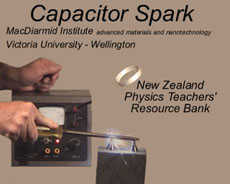Abstract

use the Video link below.
Create a spark by shorting a charged capacitor.
Portable
Yes
Principles Illustrated
Charge and discharge of capacitors, energy stored in a capacitor, high voltage safety.
Video
Download (right-click and “save link as”):
Capspark.m4v (7 MB) || CapSpark.mov (1 MB)
NCEA & Science Curriculum
PHYS 3.6
Instructions
Charge an electrolytic capacitor to near its voltage limit and short with a screwdriver in a dimly lit room. But see safety notes first.
Safety
This can be quite dangerous with a high voltage capacitor. Hold the screwdriver by the insulated handle and do not let students too near!
You can get a fairly nice spark with a low voltage and high capacitance. We have some 1 farad (not microfarad) electrolytic capacitors that are limited to 5 V but spark nicely. We recommend this safe version for schools.
Do NOT charge a capacitor above its rated voltage as this can be quite dangerous. Also, remember that older capacitors may contain quite toxic chemicals.
Individual teachers are responsible for safety in their own classes. Even familiar demonstrations should be practised and safety-checked by individual teachers before they are used in a classroom.
Related Resources
Charge and discharge a capacitor through a light bulb or ammeter, Van de Graaff
Notes
Capacitors can deliver energy very rapidly (high power). One of the many uses of this capability is in camera flash bulb circuits. The small battery in a camera cannot deliver the power to fire a flash bulb. Instead, it charges a capacitor which then delivers the energy to the bulb very rapidly.
For additional information, see http://electronics.howstuffworks.com/camera-flash3.htm.
References
PIRA: 5C30.20
Teaching Resources
Would you like to contribute lesson suggestions? Contact us.
Credits
The version of the apparatus we filmed, called the Coulomb Box, (actually a 4 microfarad 1500 V capacitor from a WW2 army radio power supply) was borrowed from Onslow College near Wellington.
This teaching resource was developed with support from
The MacDiarmid Institute
Faculty of Science, Victoria University of Wellington
School of Chemical and Physical Sciences, Victoria University of Wellington